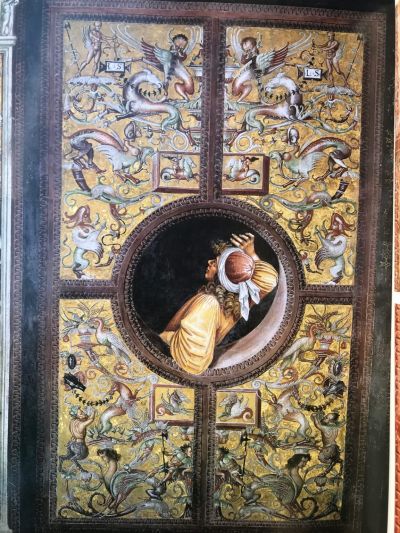“There isn’t a day that I don’t have a needle in my hand,” Antonietta told me as we talked about her passione for the embroidery of the punto Assisi (the Assisi stitch). She grew up with a passion for the punto Assisi as her mother created textile masterpieces in this stitch. As a child, Antonietta watched her mother work and at about age 15, she, too, started doing the Assisi stitch…and never stopped.
I asked Antonietta about her motifs and choices of designs, and she replied, “I love to experiment and each of my works represents me. I study the force of the work.” Many of Antonietta’s embroidery designs are inherited from a distant cousin, Maria, born in 1872, who worked on the punto Assisi from the time she was a child until her death in 1946. She taught embroidery to young Assisi women with the help of 15 assistants, also experts in the Assisi stitch. The scrolls bearing her designs have always been a family treasure. Antonietta and another cousin, also impassioned by the punto Assisi, divided the heirloom scrolls between them.
Many of these scrolls had hand-written labels scrawled by an elderly Maria which indicated little information on their artistic origins. One was labeled “Orvieto pillow.” Antonietta turned the scroll into a pillow wondering about the specific Orvieto artwork which inspired it. One day, browsing in the Zubboli bookshop in Assisi, she recognized the pillow’s designs as she gazed at photos reproducing Luca Signorelli frescoes (1499- 1502) in the San Brizio chapel of the Duomo in Orvieto. The grottesche motif in one of the Signorelli frescoes had clearly inspired Signora Maria’s design.
Other local artworks inspired artisans like Antonietta such as the carved doors of the 13th-century Basilica di San Francesco. A grinning monster with tongue out surrounded by budding flowers seems to mock those entering the Basilica’s door, and he takes center stage on Antonietta’s pillow, embroidered in green and white. Antonietta also pulls inspiration from the Deruta maiolica.
During this past year of COVID, Antonietta has embroidered an ex-voto, an image made to implore a favor or thanks for a favor received. She embroidered her ex-voto as an invocation for the good health of all, baptizing this embroidery “a pandemic ex-voto.” The inscription on the textile is an invocation to the Virgin, “Mother of all Graces” to intervene for us all. A few months after finishing the piece, Antonietta tested positive for COVID, but recovered without complications. In this case, that embroidered ex-voto played a dual role as both an implication and a thanksgiving.
Antonietta says that the medieval and Renaissance art of her region of Umbria has always been her main source of inspiration and especially in her most significant work of embroidery, the tribute to her beloved husband, Carlo Angletti, who died just over five years ago. Antonietta feels that Carletto is still with her as she continues to move that needle in and out of the linen fabrics, creating the wonders. Antonietta hopes to show her years of embroidery works at a show. “I have already decided the name of the exhibit, ‘Il Filo Amoroso’ (‘Thread of Love’).” Antonietta’s love for Assisi, its art and history and traditions thread through her embroidery. And that exhibit will be dedicated to Carlo, for she says, “He was my greatest support and always the most appreciative of anything I designed or created.”
-
 Antonietta’s ancestor’s hand-designed...
Antonietta’s ancestor’s hand-designed...
Antonietta’s ancestor’s hand-designed...
Antonietta’s ancestor’s hand-designed...
-
 Maria’s hand-stitched scroll...
Maria’s hand-stitched scroll...
Maria’s hand-stitched scroll...
Maria’s hand-stitched scroll...
-
 Luca Signorelli fresco...
Luca Signorelli fresco...
Luca Signorelli fresco...
Luca Signorelli fresco...
-
 Antonietta’s embroidery inspired...
Antonietta’s embroidery inspired...
Antonietta’s embroidery inspired...
Antonietta’s embroidery inspired...
-
 Antonietta’s embroidery inspired...
Antonietta’s embroidery inspired...
Antonietta’s embroidery inspired...
Antonietta’s embroidery inspired...
-
 Antonietta’s ex-voto
Antonietta’s ex-voto
Antonietta’s ex-voto
Antonietta’s ex-voto
https://www.lagazzettaitaliana.com/history-culture/9747-artistic-and-artisan-heritage-of-the-assisi-textiles#sigProId293507d47a



